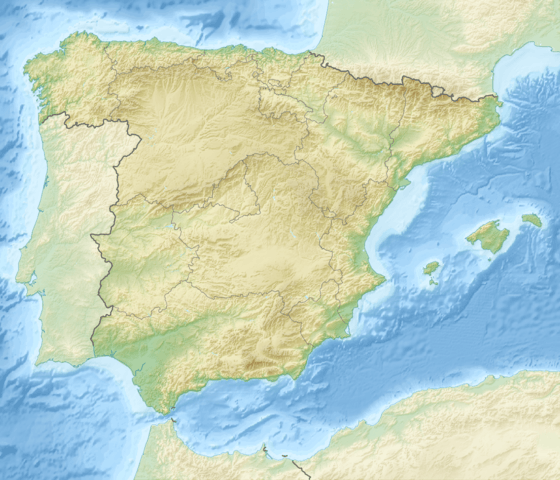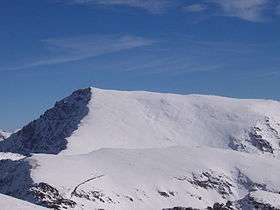Mulhacén
| Mulhacén | |
|---|---|
 | |
| Highest point | |
| Elevation | 3,478.6 m (11,413 ft) [1] |
| Prominence |
3,285 m (10,778 ft) [2] Ranked 64th |
| Isolation | 529 kilometres (329 mi) |
| Listing | Ultra |
| Coordinates | 37°03′12″N 3°18′41″W / 37.05333°N 3.31139°WCoordinates: 37°03′12″N 3°18′41″W / 37.05333°N 3.31139°W [1] |
| Geography | |
 Mulhacén Location in Spain | |
| Location | Granada, Spain |
| Parent range | Sierra Nevada |
| Climbing | |
| First ascent | unknown (before 1500)[3] |
| Easiest route | hike |
Mulhacén (Spanish pronunciation: [mulaˈθen]) is the highest mountain in continental Spain and in the Iberian Peninsula. It is part of the Sierra Nevada range in the Cordillera Penibética. It is named after Abu l-Hasan Ali, or Muley Hacén as he is known in Spanish, the penultimate Muslim King of Granada in the 15th century who, according to legend, was buried on the summit of the mountain.
Mulhacén is the highest peak in Europe[note 1] outside the Caucasus Mountains and the Alps. It is also the third most topographically prominent peak in Western Europe, after Mont Blanc and Mount Etna, and is ranked 64th in the world by prominence.[2] The peak is not exceptionally dramatic in terms of steepness or local relief. The south flank of the mountain is gentle and presents no technical challenge, as is the case for the long west ridge. The shorter, somewhat steeper north east ridge is slightly more technical. The north face of the mountain, however, is much steeper, and offers several routes involving moderately steep climbing on snow and ice (up to French grade AD) in the winter.[3]
Mulhacén can be climbed in a single day from the villages of either Capileira or Trevélez, but it is more common to spend a night at the mountain refuge at Poqueira, or in the bare shelter at Caldera to the west. Those making the ascent from Trevelez can also bivouac at the tarns to the northeast of the peak.
Accidents
On 5 March 2006, three British climbers from Teesside died on the mountain from suspected hypothermia. Initial reports quoting the Spanish Civil Guard stated that the three were ill-equipped for the extreme conditions. This claim was subsequently disputed both by the family and a colleague of one of the climbers, and by one of the rescuers.[4][5] A plaque dedicated to them has been placed at the summit.[6]
 Mulhacén from Punta de Loma Pelada
Mulhacén from Punta de Loma Pelada Mulhacén from Alcazaba
Mulhacén from Alcazaba- North face of Mulhacén
 Mulhacén in the winter from the west
Mulhacén in the winter from the west Ruined mountain hut on the summit
Ruined mountain hut on the summit Mulhacén from the Laguna Hondera
Mulhacén from the Laguna Hondera
References
- 1 2 Document supplied by Spanish National Mapping Agency. The coordinates given here have been converted from ED50 to WGS84.
- 1 2 "European ultra-prominent peaks". peakList.org. Retrieved 2015-01-24.
- 1 2 Griffin, Lindsay (1998). "Mulhacén". In Salkeld, Audrey. World Mountaineering. Bulfinch Press. ISBN 0-8212-2502-2.
- ↑ "Climbers die despite rescue bid". BBC News. 7 March 2006. Retrieved 2015-01-24.
- ↑ "Three British climbers die on Spanish mountain after son's rescue bid fails". The Guardian. 7 March 2006. Retrieved 2015-01-24.
- ↑ Photograph of the plaque at the summit dedicated to the British climbers
- Notes
- ↑ The Canary Islands and Greenland, which are politically attached to Europe, but which are geographically part of Africa and North America respectively, have higher peaks.
External links
| Wikimedia Commons has media related to Mulhacén. |
- (Spanish) Route to climb Mulhacén
- Mulhacen - Alpujarras.eu: your holiday quide, travel information and rural accommodation